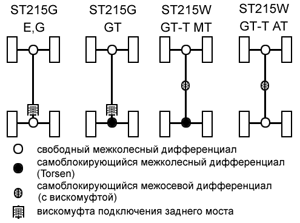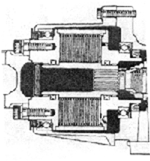|
Eugenio,77
mail@toyota-club.net
© Toyota-Club.Net
Jan 2004
Questions and disputes concerning the subject arise with the enviable regularity.
Let's try briefly to explain, what is 4WD on the second generation of Caldina...
Thus, Caldina 210 (1997-2002) was produced in the next variants:
|
Body |
Version | Engine | Drive |
| 211G | E | 7A-FE | 2WD |
| 216G | E | 3C-TE | 4WD |
| 210/215G | E | 3S-FE |
2WD/4WD |
| 210/215G | G | 3S-FE | 2WD/4WD |
| 210G/215G | GT | 3S-GE |
2WD/4WD |
| 215W | GT-T | 3S-GTE | 4WD |
The principles of 4WD operation at 215G and 215W differs from each other radically. In the old good Toyota's traditions FullTime 4WD, installed to the initially front-wheel-drive models, it was actually constant and full, with three differentials, including center, located in the common case with the gearbox. Central differential could be lockable - by servo (C.Diff Lock), either by viscous coupling, or automatically, by hydromechanical multiclutch coupling with electronic control (C. Diff Auto). But now everything was different way...

Caldina 215 4WD variants
|
Caldina 215G 4WD was implemented under the new scheme, known as "V-Flex Fulltime 4WD". It's not true "fulltime" - actuallly it is just auto-connected rear axle (more precise, rear wheels). Center differential was eliminated, and the torque through transfer (or, simply, bevel gearbox) is drive by propeller shaft to back...
But now, before the rear differential was mounted the viscous coupling, which connects the propeller shaft and the input shaft of rear differential only when front wheels slipping. In the other cases the car remains front-wheel-drive. GT version obtain Torsen type rear limited slip differential.
It is necessary to note - in technical English all limited slip differentials called "LSD". However, they are divided into viscous (with "closed" viscous coupling filled with silicone liquid), friction (the disks and plates operates in differential fluid), Torsen etc.
Caldina 215W has traditional 4WD, with the center differential in the gearbox case. Alas, there is a viscous coupling in this differential now, not a multiclutch "intelligent" coupling. Torque is transferred by propeller shaft to the input of rear differental - free (version with the automatic gearbox) or LSD Torsen (with the mechanical gearbox).
"Where can we find fluid capacities specification?"
Here are Toyota's original advices:
| AT |
Capacity | Oil |
Transfer | Capacity | Oil |
| A245E | 7,6 | ATF Type T-IV | - | - | - |
| A247E | 7,7 | ATF D-II | - | - | - |
| A241F | 8,1 | ATF D-II | MF1A | 0,9 | TM GL-5 75W-90 |
| A243F | 8,1 | ATF D-II | MF1A | 0,9 | TM GL-5 75W-90 |
| U140F | 8,1 | ATF Type T-IV | MF2AV | 1,0 | TM GL-5 75W-90 |
| MT | Capacity | Oil | Transfer | Capacity | Oil |
| C58 | 1,9 | TM GL-3 SAE75W-90 | - | - | - |
| S55F | 2,1 | TM GL-3 SAE75W-90 | MF1A | 0,9 | TM GL-5 75W-90 |
| E150F | 5,2 | TM GL-5 SAE75W-90 | EF1AV | gearbox case integrated with transfer case |
* - TM - Transmission (gear) oil.
** - all gearboxes have front differential case, integrated with gearbox case (not to be charge separately).
*** - "GL-3" here understand as "GL-4".
Rear differential - Hypoid transmission oil GL-5 SAE85W-90 (0,5 l. - V-Flex, 0,9 l. - GT-T)
As it proved to be, for some ST215G owners this principle of 4WD became discovery and, it is similar, unpleasant dicovery...
"Why V-Flex is bad?"
1) So that the viscous coupling begin to work, necessary the slippage of front wheels. Only in this case the perceptible difference in the frequency of rotation between its disks will appear, will begin warming-up and "hardening" of working fluid. But car can be buried in soil before rear wheels will turn.
2) Viscous coupling locking never was "hundred per-cent".
3) Massive elements of the real Fulltime 4WD can bear overload easily, but it can not be said about the relative delicate viscous coupling.
4) Sudden rear drive connection is potentially dangerous especially during the cornering. Therefore to avoid the random connection of rear drive (with the critical drift of the car and all ensuing consequences) coupling was made "soft", so that it would react only to the sufficiently large and prolonged difference in the rotation speed - but it made worse off-road ability.
So, functionally V-Flex worse than the real Fulltime 4WD, which used at Caldina ST195, but nevertheless it is better than nothing.
 |
"We jacked-up car and run at "D". Rear wheels also rotating. Why?"
If we start engine at deep frozen car and drop the clutch, the car will be move slightly even with neutral position of gearbox - because cold oil in the box is too viscous. Here also minimum effort is transferred constantly through the clutch, due to internal liquid friction. And it will be possible to rotate freely hanging wheel.
"What usually failed in V-Flex?"
1) The most unpleasant - one of the front wheels skid for a long time, but rear one not to be connected. If it was not happen during extreme off-road, than probably viscous coupling (41330D) fail. But new (p/n 41330-12020) costs about $1100, so much better to got to scrab collector and buy used rear differential assy for ~$400), or resign of 4WD and use "mono-driving" car.
2) Considerably more often defect - the "whistle" of the radial bearings of viscous coupling (in the figure - 41330G and 41330F). But nothing terrible, these bearings (p/n 90363-95003 and 90363-65002) are detachable and cost about $30 both (better replace both at the same time). In case of unsuccessful disassembling could be required new dust washer (in figure p/n 41252).
Toyota all-wheel drive. Review
|
|
|